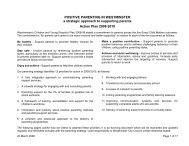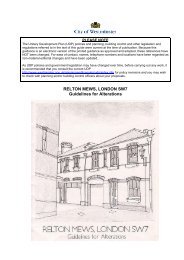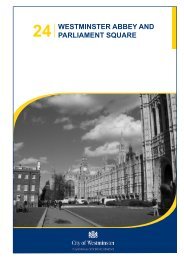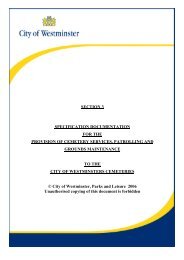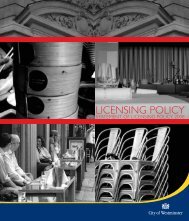Westminster Open Spaces Noise Study 2008 Final Report
Westminster Open Spaces Noise Study 2008 Final Report
Westminster Open Spaces Noise Study 2008 Final Report
- No tags were found...
You also want an ePaper? Increase the reach of your titles
YUMPU automatically turns print PDFs into web optimized ePapers that Google loves.
<strong>Westminster</strong> <strong>Open</strong> <strong>Spaces</strong> <strong>Noise</strong><strong>Study</strong> <strong>2008</strong>: <strong>Final</strong> <strong>Report</strong>Paddington Central7.1.10 An enclosed amphitheatre style lunch venue surrounded by high rise offices and flats withdistant traffic noise the dominant source. Subjectively the noise was not overly intrusive.The nearby flyover could be seen from some areas. Due to reflective nature of surroundingbuildings there would be very little benefit in providing any acoustic barriers around thespace itself. As the space is used mostly for lunching the introduction of some maskingsound may be appropriate in the form of background music or a water feature.Regent’s Park7.1.11 Central – distant traffic noise and aircraft were the dominant sources in the centre of thepark. Relatively low noise levels were measured and it is felt that there is little that could bedone to improve this area, with the exception of diverting flight paths to avoid any aircraftdirectly overhead.7.1.12 Edge – very close to Park Road (A41) which traverses the south west boundary of the park.The traffic on the road was not continuous and as such traffic calming would have littleeffect on noise levels. An increase in foliage at the boundary would be beneficial to visuallyblock the view to the road from the park. In terms of noise an acoustic barrier would be themost appropriate solution positioned as close to the road as possible.St. Mary’s Churchyard7.1.13 <strong>Noise</strong> at this site was dominated by construction and distant traffic. As construction noise istemporary this should be ignored. Significant noise barriers to the surrounding roads wouldprovide improvement and / or the planting of trees with all year round leaf coverage toprovide additional wind generated masking (rustling) sound.Hyde Park7.1.14 Central – Distant traffic was the main source of noise, contributions would be from manyroads and therefore not practicable to reduce at source. Providing a water feature on thelake may be a good way of generating some masking sound. Aircraft also a significantsource and therefore ensuring flight paths to not pass directly overhead would bebeneficial. One or more designated quiet zones could be appropriate for this site.7.1.15 Edge – The park is surrounding by roads. It is likely that acoustic barriers would be toovisually intrusive. <strong>Noise</strong> could be reduced by restricting traffic flows on these roads or usingtraffic calming measures. Where fountains are currently used these do provide somereasonable masking of traffic noise in the near vicinity. Locating noisy activities such asopen areas for sports around the edges rather than in the centre, could improve thetranquillity of the central areas.Leicester Square Gardens7.1.16 This is a busy square dominated by construction activities and the noise from people.Distant traffic noise was audible in the lulls between construction activities. More greeneryaround the edge of the gardens may psychologically help to separate the gardens from thesurroundings to give the impression of entering a tranquil space. However, many visitors toLeicester Square come to people watch and therefore this barrier could not be too visuallyintrusive. More could be made of the water feature to provide a louder masking sound. Ayfurther mitigation measures would be inappropriate as people coming to Leicester Squarewould expect to hear some noise and it is relatively quiet for a central London area.D121316/R1/0234Scott Wilson LtdMarch 2009





